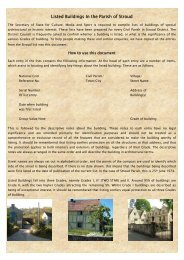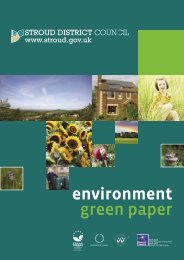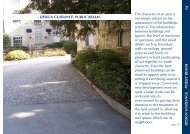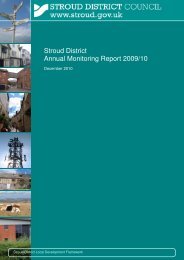- THE STUDY AREA IN ITS SETTING - The landscape and geology ...
- THE STUDY AREA IN ITS SETTING - The landscape and geology ...
- THE STUDY AREA IN ITS SETTING - The landscape and geology ...
You also want an ePaper? Increase the reach of your titles
YUMPU automatically turns print PDFs into web optimized ePapers that Google loves.
CONSERVATION <strong>AREA</strong> STATEMENT – <strong>IN</strong>DUSTRIAL HERITAGE CONSERVATION <strong>AREA</strong>: AN OVERVIEW- <strong>THE</strong> <strong>STUDY</strong> <strong>AREA</strong> <strong>IN</strong> <strong>ITS</strong> SETT<strong>IN</strong>G -<strong>The</strong> <strong>l<strong>and</strong>scape</strong> <strong>and</strong> <strong>geology</strong> of the Stroud area hasimpacted on the character of the settlementswhich populate the Study Area in a number ofways, from the types of building materials mosteasily sourced, to the types of industries thatdeveloped. <strong>The</strong> local topography forms asignificant component of views <strong>and</strong> vistas into<strong>and</strong> out of the Study Area.page 26
CONSERVATION <strong>AREA</strong> STATEMENT – <strong>IN</strong>DUSTRIAL HERITAGE CONSERVATION <strong>AREA</strong>: AN OVERVIEW<strong>THE</strong> <strong>STUDY</strong> <strong>AREA</strong> <strong>IN</strong> <strong>ITS</strong> SETT<strong>IN</strong>G4.1 <strong>The</strong> <strong>l<strong>and</strong>scape</strong> <strong>and</strong> <strong>geology</strong> of the Stroudarea has impacted on the character of thesettlements which populate the Study Areain a number of ways, from the types ofbuilding materials most easily sourced, tothe types of industries that developed. <strong>The</strong>surrounding <strong>l<strong>and</strong>scape</strong> greatly influences thefirst impressions gained on approach toStroud <strong>and</strong> many of the IHCA’s othersettlements. <strong>The</strong> local topography forms asignificant component of views <strong>and</strong> vistasinto <strong>and</strong> out of the Study Area.4.2 An abundance of natural watercourses madethe Stroud Valleys ideal as the base formanufacturing <strong>and</strong> industry, as the flowingwater provided power for the mills. A goodclean water supply was also necessary forwashing the wool used in cloth production.Industrial development naturally occurredalong the valley bottoms, notably the FromeValley, where mills could also be close toprogressively improving transport links.4.3 Today, Stroud is at the centre of an extensivenetwork of road <strong>and</strong> rail links <strong>and</strong>waterways. Many of the earliest roads thatserved the settlement ran along the tops ofthe hills, <strong>and</strong> their extreme steepness <strong>and</strong>muddiness was a deterrent to much traffic.This certainly inhibited transport <strong>and</strong> tradelinks <strong>and</strong> rather isolated the early settlement.However, the 18 th <strong>and</strong> particularly the 19 thcenturies saw transport improvements,including the construction of two majorcanals, crucially linking the Severn estuarywith the navigable river Thames, plus anumber of major new turnpike roads whichran along the valley bottoms, many of whichreplaced existing hilltop routes.4.4 Many of the improvements to transportinfrastructure led to the intensification ofdevelopment along the valley bottoms.Often this was in quite distinct phases, as forexample with the masses of new 19 th centuryhousing which began lining the br<strong>and</strong> newmain roads. <strong>The</strong> arrival of the canal <strong>and</strong>,later, the railways, introduced easy access toa wider range of building materials, meaningthat the products of the local <strong>geology</strong>became subtly less evident in the buildingswhich sprang up.Left:An outcrop ofoolitic limestonein the AveningValley. <strong>The</strong>rubblestone <strong>and</strong>freestone layerscan be clearlyseen.Analysis: the Conservation Area in its setting page 27
CONSERVATION <strong>AREA</strong> STATEMENT – <strong>IN</strong>DUSTRIAL HERITAGE CONSERVATION <strong>AREA</strong>: AN OVERVIEWGEOLOGY4.5 Between about 185 <strong>and</strong> 140 million yearsago, during the Jurassic period, a vastlimestone belt was created, stretchingbetween Lincolnshire <strong>and</strong> the Dorset coast.<strong>The</strong> Cotswolds, a region of ambiguousboundaries, is usually held to constitute thehighest part of this belt, a plateau which risesfrom the east in Oxfordshire <strong>and</strong> descends ina dramatic escarpment to the west, withinsight of Stroud.4.6 During the Jurassic period, a shallow seacovered the area, in which a sequence ofsediments settled into alternating layers or‘strata’ of clay, s<strong>and</strong> <strong>and</strong> limestone. Althoughthe beds of sediment were each laid downon a virtually horizontal level, subsequentprocesses have resulted in shifts in theterrain, so that, in places, strata of quitediverse ages <strong>and</strong> substance have ended upnext to each other. <strong>The</strong> whole Cotswoldplateau has been tilted, so that the west hasrisen up, while the east has sunk. Erosion<strong>and</strong> climatic changes have also played theirpart in shaping the <strong>l<strong>and</strong>scape</strong>.4.7 In the past, the whole Cotswold formationwas known as <strong>The</strong> Oolite, due to theprevalence of this form of limestonethroughout the region. Limestone, <strong>and</strong> inparticular oolitic limestone, is extremelypermeable, <strong>and</strong> where it meets beds ofimpervious clay, water is driven out in theform of springs. Hence the Cotswolds areriddled with streams <strong>and</strong> brooks as well asrivers. <strong>The</strong>se have been highly active in theformation of the topography, carving deep<strong>and</strong> complex valleys into the ‘Oolite’plateau, a process which continues <strong>and</strong>means that the <strong>l<strong>and</strong>scape</strong> is ever changing.4.8 Due to its porous nature, oolitic limestone is‘soft’ when it is newly extracted <strong>and</strong> may beeasily worked. <strong>The</strong> mass of oolite is in twobasic layers, separated by a narrow bed ofFullers Earth: the older, deeper layers beingknown as the ‘Inferior Oolite’ <strong>and</strong> the upperlayers as ‘Great Oolite’.4.9 <strong>The</strong> tilt of the Cotswolds means that thelower layers, the ‘Inferior Oolite’, areexposed along the western escarpment,where they are more easily accessible thanin the eastern Cotswolds. <strong>The</strong> hills encirclingStroud were particularly rich in good qualityLower Inferior Oolite stones, known bymasons as ‘Freestones’, due to the ease withwhich they can be cut <strong>and</strong> dressed. Amongthese is Lower Freestone, of which the finePainswick Stone is a variety, <strong>and</strong> LowerLimestone, the eldest of the strata, of whichthere is a large outcrop at Frocester Hill.Upper Freestone is of poorer quality, mostlyused for burning, to create lime mortars <strong>and</strong>plasters. At Stroud, though, it was sufficientlygood to be used for many of the town’s‘rock-faced’ rusticated buildings.4.10 <strong>The</strong> Severn Vale has been subject to verydifferent geological processes. Though alsoformed in the Jurassic period, later ages haveseen the <strong>geology</strong> of the Vale stronglyinfluenced by the River Severn <strong>and</strong> itssmaller tributaries, including the river Frome.4.11 <strong>The</strong> Vale is essentially a large flood plain.Successive floods <strong>and</strong> changes in the courseof the rivers have left the older, Lower Lias,rocks covered with alluvial silts, pebbles <strong>and</strong>clays, the residue of the materials found onthe riverbeds.4.12 Clay is predominant in the Severn Valebelow Stroud. Its impermeable intractablenature has meant that the river Frome hasnot formed deep narrow incisions into the<strong>l<strong>and</strong>scape</strong>, but has instead created a broad<strong>and</strong> shallow river valley.4.13 <strong>The</strong> clay has proved useful in lining thefloors of millponds <strong>and</strong> canals in the area. Itis also ideal for brick making, providing abuilding material in an area lacking anabundant supply of stone.Analysis: the Conservation Area in its setting page 28
CONSERVATION <strong>AREA</strong> STATEMENT – <strong>IN</strong>DUSTRIAL HERITAGE CONSERVATION <strong>AREA</strong>: AN OVERVIEWTOPOGRAPHY AND LANDSCAPE4.14 <strong>The</strong> Industrial Heritage Study Area falls intotwo very distinct topographical areas. To thewest of Stroud, slicing through the Cotswoldescarpment, is the river valley of the lowerFrome. As the Frome flows towards theSevern, this becomes increasingly broad <strong>and</strong>shallow, the <strong>l<strong>and</strong>scape</strong> flattening out to the‘Vale’.4.15 To the north, south <strong>and</strong> east of the StudyArea are the Stroud valleys. <strong>The</strong> IHCA runsalong two of the most populated of these:the Chalford valley, through which the upperFrome flows, <strong>and</strong> the Nailsworth valley,which carries the Nailsworth Stream. <strong>The</strong>sevalleys are steep sided, gradually descendingfrom the high ground of the Wolds towardsthe Severn Vale. Both have several smallervalleys branching from them. Two of thesebranch valleys – Toadsmoor in the Chalfordvalley <strong>and</strong> Avening in the Nailsworth valley– are included in the IHCA Study Area.4.16 Most of the hillsides overlooking the lengthof the study area are capped with Commonl<strong>and</strong>. <strong>The</strong> relationships between the<strong>l<strong>and</strong>scape</strong>, transport links <strong>and</strong> the builtenvironment can be best appreciated whenviewed from the heights ofMinchinhampton, Rodborough <strong>and</strong> SelsleyCommons.4.17 Beyond Dudbridge, much of the LowerFrome valley is predominately rural: quietlanes are surrounded by water-meadowscontaining networks of ditches <strong>and</strong> drainsbordered by pollarded willow <strong>and</strong> eldertrees. <strong>The</strong> l<strong>and</strong> has a variety of uses fromorchards, pasture <strong>and</strong> arable fields tomanaged parkl<strong>and</strong> with mature specimentrees.4.18 <strong>The</strong> lack of stone in the Severn Vale hasstrongly influenced the overall look of thearea. Fields are bounded by hedges <strong>and</strong>many village gardens are enclosed with ironrailings or walls constructed from bricksmade locally.4.19 <strong>The</strong> flat nature of the countryside givesprominence to man made features. <strong>The</strong>re isobvious dialogue between the scatteredsettlements, the church towers sometimesbeing visible from one village to another.Other features such as the Stroudwatercanal, which crosses the countryside on a‘causeway’ here, electricity pylons <strong>and</strong>World War II pillboxes also clearly impacton the <strong>l<strong>and</strong>scape</strong>.4.20 <strong>The</strong> Vale is cut from north to south by theM5 motorway <strong>and</strong> the A38, which break thegeneral east-west orientation of the historicriver/road/canal transport infrastructure. Thisis very apparent when viewed from the highground of the escarpment. <strong>The</strong> sound of themotorway can be heard from time to time.4.21 Mills punctuate the length of the conservationarea in the lower Frome valley, most ofwhich are, or have been, linked to thehistoric transport routes. <strong>The</strong> sense ofisolation of the mills <strong>and</strong> their originalsetting is largely preserved. This isparticularly evident when they are viewedfrom the water meadows, where, as atBond’s, Beard’s <strong>and</strong> Upper Mills, the millsare within sight of each other.4.22 <strong>The</strong> width of the valley <strong>and</strong> good transportlinks have allowed the mills to exp<strong>and</strong>; the two‘supermills’, Ebley <strong>and</strong> Stanley, are clearlyvisible from the hills in Stroud, up to threemiles away.4.23 <strong>The</strong> topography has also allowedcommunities to grow up on the lower slopesof the shallow valley, many of them directlyrelated to the historic industrial <strong>l<strong>and</strong>scape</strong>:canal settlements, such as Newtown, 19 thcentury roadside development, <strong>and</strong> millrelated buildings, including rows of workers’cottages.Analysis: the Conservation Area in its setting page 29
CONSERVATION <strong>AREA</strong> STATEMENT – <strong>IN</strong>DUSTRIAL HERITAGE CONSERVATION <strong>AREA</strong>: AN OVERVIEWAbove:Fields are often enclosed byhedges <strong>and</strong> ditches or by ironfences in the Vale, while drystonewalls are more common in thevalleys. Church towers are majorvertical l<strong>and</strong>marks in this flat<strong>l<strong>and</strong>scape</strong>Top left:A view of the Severn Vale fromSelsley Common. Stanley Mill, oneof Stroud’s ‘supermills’ is visiblebottom right.Left:<strong>The</strong> Cotswold escarpment forms adistinctive backdrop to manyviews across the flat Vale<strong>l<strong>and</strong>scape</strong>.Bottom left <strong>and</strong> below:Since the late-19 th century, themain roads have been underincreasing development pressure,with gaps between settlementsbeing infilled by housing orindustry, creating an impression oflinear or continuous settlement,which is at odds with the historicisolation of many mills <strong>and</strong> smallersettlement groups. <strong>The</strong> rhythmicpattern of settlement along theFrome watercourse is still evidentonce you get off-road though.Analysis: the Conservation Area in its setting page 30
CONSERVATION <strong>AREA</strong> STATEMENT – <strong>IN</strong>DUSTRIAL HERITAGE CONSERVATION <strong>AREA</strong>: AN OVERVIEW4.24 Much of the road corridor has been infilledwith modern industry <strong>and</strong> housing, althoughthe access routes to the mills <strong>and</strong> hillsidecommunities still remain. Leaving the mainroad at right angles, the lanes are carriedover the river <strong>and</strong> canal by the many redbrick accommodation bridges. <strong>The</strong> l<strong>and</strong> thatslopes away below the canal to the south hasremained largely undeveloped.4.25 Whilst views of the bare grassl<strong>and</strong> of theescarpment provide a constant conspicuousbackdrop to the south of the Study Area,Doverow Hill in Stonehouse heralds the startof the more wooded hillside to the north.<strong>The</strong> impact of this hillside, with its scatteredweaving settlements such as R<strong>and</strong>wick <strong>and</strong>Ruscombe, becomes greater as the lowerFrome valley approaches Stroud. From thispoint, the conservation area is defined <strong>and</strong>channelled between the steep slopes of theupper Frome valleys’ sides.4.26 <strong>The</strong> hillside urban expansion of Stroud town<strong>and</strong> the Victorian red brick suburb ofRodborough dominate the eastern view atthis end of the western leg of the IHCA. <strong>The</strong>bowl of the valley at the foot of the hill atWallbridge forms the meeting point of theIHCA transport infrastructure <strong>and</strong> from here,the Chalford <strong>and</strong> Nailsworth valleys branchaway.4.27 Unlike the lower Frome valley, the Stroudvalley legs to the east <strong>and</strong> south of the StudyArea are dominated by their <strong>l<strong>and</strong>scape</strong>. <strong>The</strong>hills, which rise sharply on both sides of thevalleys, are largely hung with beech woodsinterspersed with steeply sloping pasturefields.4.28 Mills are found along the length of the Stroudvalleys’ in the Study Area. <strong>The</strong>se do not havequite the same visual impact on the<strong>l<strong>and</strong>scape</strong> as those in the lower Frome valley,however their scale <strong>and</strong> tall chimneys providel<strong>and</strong>marks in the valley bottoms.4.29 Victorian roadside development, the additionof ancillary buildings to the mills <strong>and</strong> recenthousing developments on former mill siteshave, to an extent, blurred the boundariesbetween valley floor settlements. Inparticular, growing development has led tothe loss of the historic open spaces betweenmills, diminishing their once distinctiveisolation.4.30 It is possible to regain some sense of themills’ former settings by following nearbyfootpaths. However, the mills in the ChalfordValley can be appreciated best from the train.From this vantage point they can be viewedat close quarters, <strong>and</strong> the height of therailway line above the valley bottom allowsan underst<strong>and</strong>ing of the mill complexes as awhole.4.31 With the exception of small enclaves foundat key crossing points such as Bowbridge,<strong>and</strong> 19 th century red brick roadsidedevelopment, historic domestic settlement inthe Stroud Valleys has been predominantly onthe sides of the hills, rather than the valleyfloors.4.32 <strong>The</strong> houses cluster along the spring line onthe hillsides, usually around the paths <strong>and</strong>roads that once linked the mills to the mainroutes out of the valleys. Along the length ofthe southern <strong>and</strong> eastern legs of the StudyArea, it is possible to see a direct linkbetween the mills in the valley bottoms, thehomes of the people who worked in them<strong>and</strong> the routes connecting the two. Many millworkers’ hamlets have exp<strong>and</strong>ed into largevillages, such as Amberley, Woodchester <strong>and</strong>Chalford. Others, such as Bagpath, haveremained small <strong>and</strong> relatively isolated.4.33 <strong>The</strong> settlements, generally built between the17 th <strong>and</strong> early 19 th centuries, are predominatelyconstructed from stone, as are the mills theyserved. <strong>The</strong>ir position on the steep hillsides hasentailed the construction of terraces of drystone retaining walls to support houses <strong>and</strong>gardens. Road <strong>and</strong> rail embankments have alsobeen shored up with massive stone walls; thenatural <strong>l<strong>and</strong>scape</strong> has been painstakinglyartificially shaped to allow habitation <strong>and</strong>transport infrastructure.Analysis: the Conservation Area in its setting page 31
CONSERVATION <strong>AREA</strong> STATEMENT – <strong>IN</strong>DUSTRIAL HERITAGE CONSERVATION <strong>AREA</strong>: AN OVERVIEWTop left <strong>and</strong> top right:St Mary’s Mill, Chalford, <strong>and</strong> DunkirkMill, Nailsworth. <strong>The</strong> valley bases arepredominantly left to industry <strong>and</strong>agriculture, while settlement historicallyclustered along the springlines, withweaving hamlets perched above themills they served. Tall mill chimneyspunctuate the rhythmic pattern of mills,dotted along the River Frome, theNailsworth Stream <strong>and</strong> the ToadsmoorBrook.<strong>The</strong> deciduous wooded valley slopesform a colourful backdrop to manyviews in the eastern <strong>and</strong> southern legsof the Study Area.Far right <strong>and</strong> below:<strong>The</strong> lower valley slopes have often beenpainstakingly shaped, with viaducts <strong>and</strong>terraces (often dry stone walls) allowingthe steep l<strong>and</strong> to be colonised forsettlement or to carry ‘layers’ oftransport infrastructure.Bottom right:At the extremities of the Study Area arethe “secluded valleys” (Avening Valley,Toadsmoor Valley <strong>and</strong> the GoldenValley beyond Chalford), where thewindowing watercourses carve up theflat watermeadows, <strong>and</strong> settlement issparseAnalysis: the Conservation Area in its setting page 32
CONSERVATION <strong>AREA</strong> STATEMENT – <strong>IN</strong>DUSTRIAL HERITAGE CONSERVATION <strong>AREA</strong>: AN OVERVIEW4.34 <strong>The</strong> narrow Stroud valley floors have dictatedthe positioning of the transport links. This isparticularly obvious in the Chalford valleywhere the river, canal, road <strong>and</strong> railway runparallel with each other <strong>and</strong> are visuallyconnected for much of the length of theIHCA.4.35 This provides a perfect snapshot of thetransport system’s evolution in the valleysover hundreds of years. In contrast, theToadsmoor <strong>and</strong> Avening valleys give anindication of a less industrialised age, theirmills being largely untouched by theinfluence of the canal <strong>and</strong> railway.4.37 Towards the heads of the valleys, thetransport links begin to diverge: the mainroads wind uphill towards the escarpmentplateau <strong>and</strong>, in the Chalford valley, therailway line disappears into the Sappertontunnel. Only the canal <strong>and</strong> river remainparallel by the time the IHCA reaches its endpoint at Sapperton.4.38 <strong>The</strong> juxtaposition of the narrow winding riverwith the straight line of the Thames <strong>and</strong>Severn canal provides a clear insight into thereasoning behind the first improvement oftransport communications in the Stroudvalleys.4.36 As the valleys thread away from the stretchesof industrial development between Stroud<strong>and</strong> Brimscombe, <strong>and</strong> Rodborough <strong>and</strong>Nailsworth, they become steeper <strong>and</strong>narrower. <strong>The</strong> <strong>l<strong>and</strong>scape</strong> becomespredominately rural <strong>and</strong> more denselywooded. Settlements are small <strong>and</strong> scattered<strong>and</strong> the remnants of mill sites retain theirhistoric isolation.Analysis: the Conservation Area in its setting page 33
















